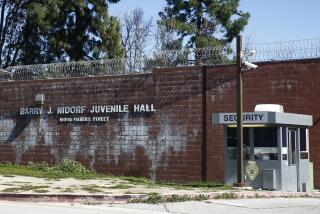Remote County Finds Its Coffers Almost Empty
- Share via
CRESCENT CITY, Calif. — By now, Del Norte County knows the language of job layoffs. Timber mills in the far northwest corner of California have closed, going from 50 to just a handful. Commercial fishing in this coastal community has dried up.
Today, even government employees are being threatened with layoffs, because Del Norte County is going broke.
County officials say they’ve cut as much as they can from their $34-million budget and now need $1.7 million from the state to pay for increases in state-mandated programs, such as foster care, to balance their books. California, with its own budget problems, won’t help.
“The problem is, there’s just not enough revenue,” said Martha McClure, a Del Norte County supervisor. “We’re in a bare-bones situation and they want us to go into the marrow.”
Most of the county’s budget pays for state-mandated programs. The county’s public safety, health and local government programs split the remaining $9 million.
Counties raise money through sales and property taxes and vehicle license fees, much of which goes to the state.
Del Norte, population 28,000, once supplemented its income with timber-yield taxes, which in the late 1970s brought in more than $1 million annually. But this year, those fees will only bring in $80,000.
Three-quarters of the rural county on the Oregon border is owned by the government, which doesn’t pay property taxes. A proposed sale of 26,000 acres of timberland will further dent an already tight budget, said Supervisor Clyde Eller.
The Save the Redwoods League plans to buy the Mill Creek property, owned by Oregon-based Stimson Lumber Co., then transfer it to the state park system. The $60-million purchase price goes to the landowner, and there are no plans yet to offset the county’s loss of property taxes, Eller said.
Stimson stopped logging last November but had continued to pay about $55,000 a year in property taxes.
Del Norte will miss the money, said County Auditor-Controller Christie Babich. She and County Administrative Officer Jeannine Galatioto are trying to find enough fat in an already lean budget to cover county workers’ salaries, including sheriff’s deputies.
The pair has managed to bring in two large capital projects under budget and spend the leftover money to fix a third county building. In October, a state Department of Finance auditor pronounced Del Norte’s business practices sound.
“We’re weren’t squandering our money on high pay and fast cars,” McClure said.
In a letter to Del Norte supervisors earlier this month, Department of Finance Director Tim Gage said giving the county money “would not be consistent with the current state-local government financing relationship or the state’s current financial situation.”
State officials have to cut at least $12.4 billion in spending over the next two years.
“Del Norte County has some unique characteristics that present challenges,” Gage wrote, but county officials can eliminate the county’s contingency reserve, roll back a salary increase and require employees to pay half of a health benefit increase.
The county isn’t alone, the state told Del Norte officials, and helping one county would cause 57 others to line up at the state’s door.
State officials don’t “seem to get it,” McClure said. “This branch of government isn’t making it.” If giving Del Norte money causes other counties to ask too, so be it, she said.
Assemblywoman Virginia Strom-Martin, a Democrat who represents the region, said the Legislature has tried to fix the complex way counties are financed.
“Maybe the time has now come,” Strom-Martin said. “However, this is the worst possible year. Everybody is being asked to take deep cuts.”
The state auditor also suggested cutting the county’s parks and recreation budget in half, but Galatioto said most of the program had already been eliminated. Now there are two parks employees, who also pick up trash in more than 100 acres of parks.
“We’re getting a bargain,” she said.
To that, the state said: Sell the parks.
Del Norte has had tight budgets before, Galatioto said. In the late 1980s, it welcomed the new Pelican Bay State Prison, which brought about 1,300 jobs and was touted as the answer to the county’s financial troubles. The state’s maximum-security prison, it’s now the county’s largest employer.
Each year, the state reimburses Del Norte for any prison-related costs, such as higher court costs. Any altercations at the prison are handled in the local court, which drives up costs. But the fee, $100,000 this year, drops each year, and eventually the state’s payments will end.
Many California counties face similar problems, said Pat Leary, legislative representative for the California State Assn. of Counties. County governments have more mandated programs to handle and fewer ways to pay for them, she said.
“They’re stuck with very few tools to deal with their own fate,” she said. “Del Norte is there now, but we’ve had other counties on the brink.”
The state has helped before, such as in 1990, when then-Gov. George Deukmejian helped put off Butte County’s bankruptcy proceedings by signing an $11.1-million bailout plan that included a $2.3-million loan.
“In a lot of ways,” Leary said, Del Norte “may be a harbinger of things to come.”
The county has already carried out most of the cuts recommended by the state, Babich said. “We’ve taken days off without pay,” she said.
Still, the county has some options, Eller said.
It could follow the state’s recommendation and rent beds in the new juvenile hall--which costs an extra $550,000 a year--to other counties, Eller said.
The county’s remaining industry--tourism--operates only half the year. In the summer, the county earns income through sales and hotel taxes. But once the rain starts, the tourists stop. Not even the picturesque Battery Point lighthouse can lure tourists in the winter season that usually brings more than 100 inches of rain.
“Tourism is not the solution,” Eller said.
Ecotourism in the Redwoods National and State parks and on the Smith River has increased, bringing in campers, hikers and kayakers, he said. “But it’s not like full-time manufacturing jobs. Even with tourism, the jobs created pay significantly less.”
Unless the county’s airport is expanded, tourism will continue to be limited by the remoteness of the area, Eller said. It’s a seven-hour drive from San Francisco, much of it on a winding two-lane highway.
The Federal Aviation Administration is set to help the county upgrade the airport with $9 million in improvements, but the county will have to pay 10%.
But even that share, $900,000, may be impossible to raise, Eller said.
More to Read
Sign up for Essential California
The most important California stories and recommendations in your inbox every morning.
You may occasionally receive promotional content from the Los Angeles Times.












